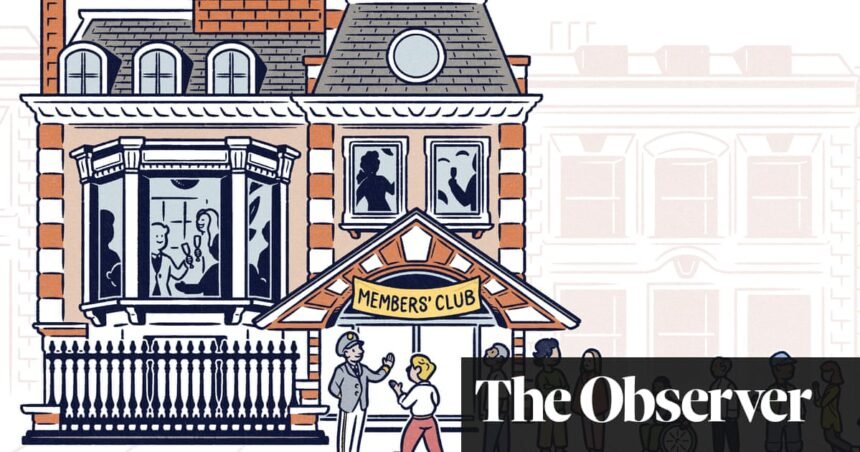When Michelle Fisher became involved with the Walthamstow Trades Hall, a social club in north-east London, she was surprised by the enthusiasm new members showed for their membership pack. It consists of a faux-leather wallet, a membership card, and a door fob, yet people frequently inquired, “Is my wallet ready yet?” Fisher chuckles at this. “People just want to be part of something,” she notes, especially during difficult times. This sense of community has been central to the recent revival of Walthamstow Trades Hall.
Established in 1919 as a working men’s club, the unassuming building is located on a residential street, with its sign now reading “T AM OW TR DES A L” due to missing letters. The club’s open ethos has allowed it to regain vitality. On my rainy summer visit, I found Fisher, a friendly 32-year-old with her hair tied back in a scrunchie, in the expansive main hall, typing on her laptop as bar deliveries arrived. She serves as the club’s secretary while working in tech, and she highlights that all committee members are volunteers. When Fisher joined, the club’s membership was in decline, mirroring the fate of many former working men’s clubs nationwide. “It wasn’t financially viable, so we thought: how do we re-engage our local community?” she explains.
To attract new members, they emphasized inclusivity—bunting made from gay Pride flags adorns the rafters, contrasting with the traditional décor of dark wood and patterned carpets. The club has made efforts to welcome the local South Asian community, many of whom don’t drink. Last year, during the energy crisis, the club received funding to serve as a community living room, where anyone could come in, relax, enjoy tea, and charge their phones. They host a variety of events—karaoke nights, tea dances for seniors, choir practices, toddler sessions, quizzes, and comedy nights. This strategy has worked: membership surged by 105% last year, and another 60% this year, spanning ages from 19 to 93. “We’re all floating about in cities, and it’s hard to find something tangible to attach ourselves to,” Fisher reflects. “Providing that is really special.”
Private members’ clubs are a longstanding element of British social life, appearing in numerous forms. “Everyone knows what a pub is, but the interpretation of a ‘club’ varies with upbringing, class, and geography,” explains Sean Ferris, publisher of several club trade magazines and organizer of the annual Club Awards. Working men’s clubs were once vital to working-class life, while gentleman’s clubs represent high society. Clubs like Walthamstow Trades Hall are reconsidering their community offerings, serving as venues open to all, especially since many local public spaces, like community centers and libraries, have been sold off following years of austerity. As Maurice Champeau, manager of Crookes Social Club in Sheffield, notes, “For your £5-a-year membership, you have access to the building while it’s open, and there’s no obligation to buy drinks.” His club generates revenue through public events, allowing for low membership costs.
Meanwhile, elite clubs are evolving away from old-style environments and now offer gyms, spas, and co-working spaces for high-earning young professionals. New elite clubs, like AllBright, Twenty Two, and George, pop up regularly, and Soho House Group continues to grow its base of over 200,000 members worldwide. Despite some financial challenges, interest in private club membership remains strong. But why does this tradition endure? Is it simply a craving for community, as Fisher suggests, or is there more at play?
The contrast between the sticky floors of Walthamstow Trades Hall, with its affordable £35 annual membership, and the high-cost privileges of Soho House, at around £2,000, highlights the intertwined histories of clubs. Seth Alexander Thévoz, author of “Behind Closed Doors: The Secret Life of London Private Members’ Clubs,” notes that the British fascination with socially structured environments persists across diverse club formats. Many of today’s clubs, from the Garrick Club for actors to the Farmers Club for landowners, originated to foster elite networks, reflecting societal hierarchies of the time.
These historic clubs still exist, though some retain outdated membership rules, prompting recent controversy regarding their exclusionary practices. The Garrick Club, known for its men-only membership, recently began admitting women for the first time due to public pressure. Such clubs tend to flourish in politically and socially tumultuous times; their evolution often aligns with broader societal changes, as seen in the emergence of new clubs responding to contemporary values.
Clubs often see heightened membership during economic downturns, as they offer value for those seeking affordable social settings. As Amy Milne-Smith, author of “London Clubland,” indicates, today’s private members’ clubs reflect a resurgence of elitism, where the social standing once sought by the Victorian elite continues to appeal to contemporary professionals.
Brian Clivaz, an experienced restaurateur and club entrepreneur, emphasizes that the essence of a successful club lies in community. Having established various clubs over the years, he believes the members create the atmosphere: “The major reason clubs fail is they don’t get that community right.” Clivaz highlights a simple test for a viable club environment: the ability to strike up a conversation with a stranger at the bar.
The appeal of clubs often lies in their familiar, safe environments. For instance, Eleanor, a 37-year-old advertising executive who joined Soho House, valued its comfort while dating. However, she acknowledges the status associated with membership. This marks a core aspect of high-end clubs—the social aspiration tied to exclusive memberships, where a club’s cachet becomes central to its allure.
Clubs continually navigate the delicate balance between exclusivity and the need for new members. As seen with Soho House, rapid expansion can lead to dilution of that exclusivity, leading to criticism and, in some cases, loss of existing membership. Members often express reluctance to change entry rules despite evolving social norms.
Despite these shared values, elite clubs thrive on prestige while working men’s clubs struggle for survival. As Champeau notes, many are on the brink of extinction unless they adapt. That’s why Crookes, once on the verge of closure, successfully opened its doors to the public and diversified its events. While some members resist this shift, the club is flourishing today.
At Walthamstow Trades Hall, embracing inclusivity has proven effective too, with Pride flags initially causing some concern among older members. However, this effort to welcome everyone has gradually won over critics, preserving longstanding traditions like monthly tea dances. Fisher believes the club offers something stable amidst chaos: “Political climates change, but clubs provide a constant,” she asserts. “These spaces should be protected—they are fundamental to the society we aspire to be.”





